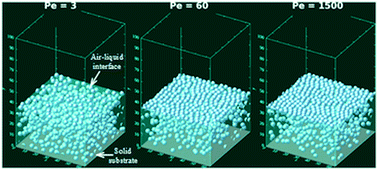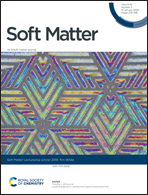Temporal evolution of concentration and microstructure of colloidal films during vertical drying: a lattice Boltzmann simulation study†
Abstract
We study the temporal and structural development of colloid films during vertical drying using the lattice Boltzmann (LB) simulation. The dispersed particles moving in Brownian motion have excluded volume and hydrodynamic interactions in the film. The concentrated colloidal film formed by solvent evaporation is modeled as an uniaxial compression of colloids with a planar moving interface. The simulation studies are carried out over a wide range of Péclet number (Pe), the relative ratio between the evaporation rate and the diffusion rate of colloids. The results clearly demonstrate a temporal variation of colloid concentration as the evaporation rate increases. In the case of high Pe, the increase of colloid concentration in the top layer creates structural features that can be distinguished along the height of the film, and eventually can induce a large tensile stress in the layer. However, surprisingly, the colloids are maximally crystallized in the case of moderate Pe. The LB simulation results are further compared with those from previous studies of the Brownian Dynamics (BD) simulation and the continuum model for the evaporation film. The LB and BD results match well both at low and high Pe limits. The qualitatively significant differences between LB and BD simulations at a moderate Pe indicate that hydrodynamic interactions (HIs) play an important role in this Pe. The presence of HIs induces a greater reduction of diffusion than under geometrical restriction alone, and the effect is conspicuous when particles are driven both by diffusion and by advection.



 Please wait while we load your content...
Please wait while we load your content...